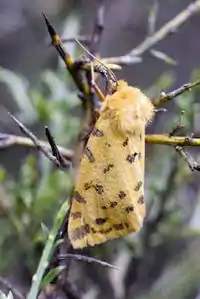Diacrisia purpurata
Diacrisia purpurata, the purple tiger, is a moth of the subfamily Arctiinae. The species was first described by Carl Linnaeus in his 1758 10th edition of Systema Naturae. It is found in Europe, Anatolia, Syria, Transcaucasus, Central Asia (mainly in Kazakhstan and Kyrghyzstan), southern Siberia, Mongolia, Amur Region, northern China, Korea and Japan (Honshu).
| Diacrisia purpurata | |
|---|---|
 | |
| Scientific classification | |
| Domain: | Eukaryota |
| Kingdom: | Animalia |
| Phylum: | Arthropoda |
| Class: | Insecta |
| Order: | Lepidoptera |
| Superfamily: | Noctuoidea |
| Family: | Erebidae |
| Subfamily: | Arctiinae |
| Genus: | Diacrisia |
| Species: | D. purpurata |
| Binomial name | |
| Diacrisia purpurata | |
| Synonyms | |
| |

Ventral side

The length of the forewings is 18–22 mm for males and 22–25 mm for females. The moth flies June to August depending on the location.
The larvae feed on Calluna and sometimes other herbaceous plants and deciduous trees.
The species of the genus Rhyparia, including this one, were moved to Diacrisia as a result of phylogenetic research published by Rönkä et al. in 2016.[1]
References
- Rönkä, Katja; Mappes, Johanna; Kaila, Lauri; Wahlberg, Niklas (2016). "Putting Parasemia in its phylogenetic place: a molecular analysis of the subtribe Arctiina (Lepidoptera)". Systematic Entomology. 41 (4): 844–853. doi:10.1111/syen.12194.
External links
Wikimedia Commons has media related to Rhyparia purpurata.
Wikispecies has information related to Diacrisia purpurata.
- Fauna Europaea
- Lepidoptera of Belgium Archived 2019-07-22 at the Wayback Machine
- Lepiforum e.V.
- De Vlinderstichting (in Dutch)
This article is issued from Wikipedia. The text is licensed under Creative Commons - Attribution - Sharealike. Additional terms may apply for the media files.